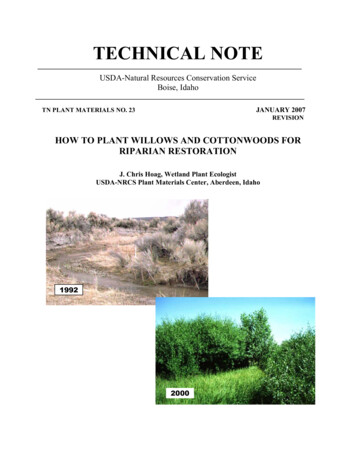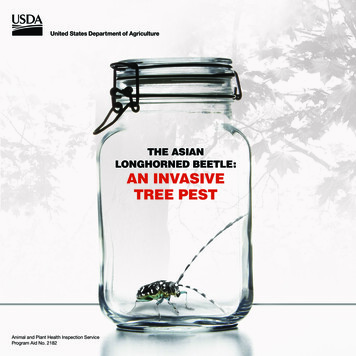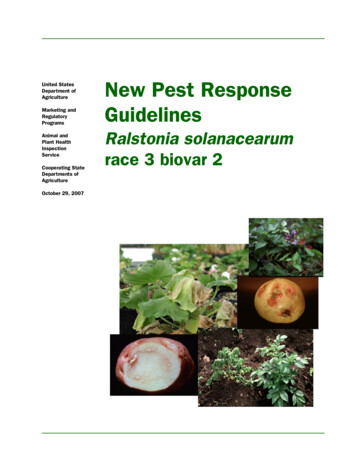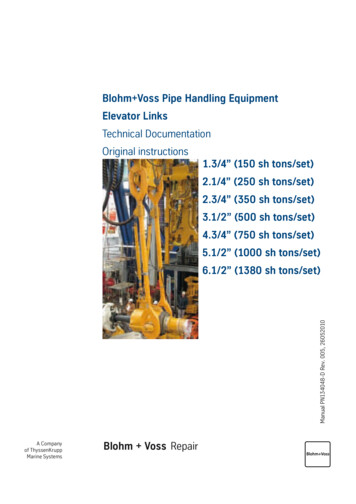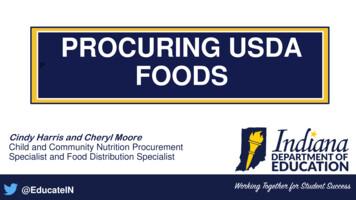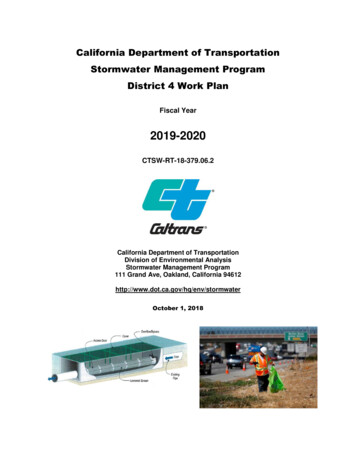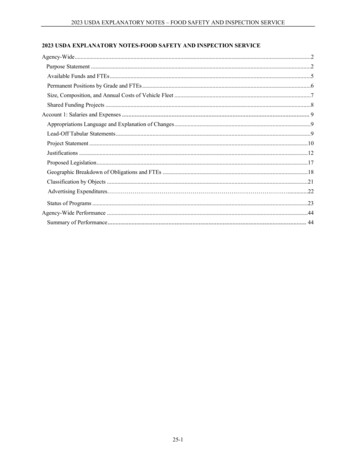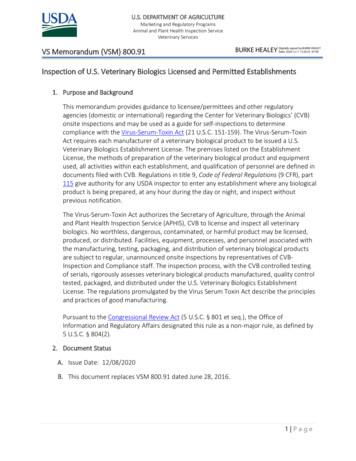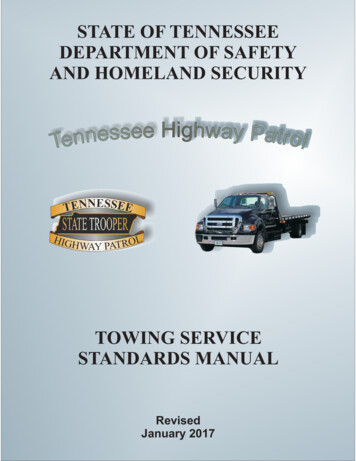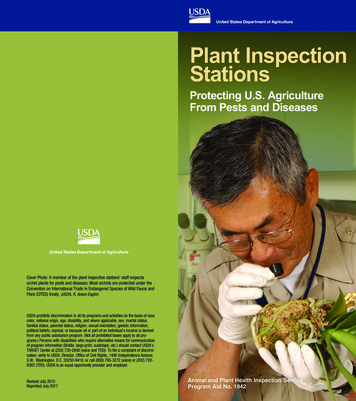
Transcription
Plant InspectionStationsProtecting U.S. AgricultureFrom Pests and DiseasesCover Photo: A member of the plant inspection stations’ staff inspectsorchid plants for pests and diseases. Most orchids are protected under theConvention on International Trade in Endangered Species of Wild Fauna andFlora (CITES) treaty. (USDA, R. Anson Eaglin)USDA prohibits discrimination in all its programs and activities on the basis of race,color, national origin, age, disability, and where applicable, sex, marital status,familial status, parental status, religion, sexual orientation, genetic information,political beliefs, reprisal, or because all or part of an individual’s income is derivedfrom any public assistance program. (Not all prohibited bases apply to all programs.) Persons with disabilities who require alternative means for communicationof program information (Braille, large print, audiotape, etc.) should contact USDA’sTARGET Center at (202) 720-2600 (voice and TDD). To file a complaint of discrimination, write to USDA, Director, Office of Civil Rights, 1400 Independence Avenue,S.W., Washington, D.C. 20250-9410, or call (800) 795-3272 (voice) or (202) 7206382 (TDD). USDA is an equal opportunity provider and employer.Revised July 2015Reprinted July 2017Animal and Plant Health Inspection ServiceProgram Aid No. 1942
Each year,billions of plants,plant cuttings,seeds, and otherplant materials are carried,mailed, and shipped into the United States,contributing to the diversity of products availablein the U.S. marketplace and enhancing oureconomy. Along with the benefits internationaltrade affords us, the import of plant andagricultural products brings risks. Pests anddiseases in infested shipments could threatenour native plants, agriculture, and naturalresources. Helping to balance the benefits andrisks of global plant trade is the responsibility ofthe U.S. Department of Agriculture (USDA) and itsplant inspection stations.Most propagative plant imports move forward toa USDA plant inspection station upon arrival atthe port of entry. The plant inspection stations’staff of scientists, plant health safeguardingspecialists, and support personnel make surethe material is free of USDA-regulated pests anddiseases and meets U.S. plant health importstandards before releasing the shipment to itspermitted destination. This is part of USDA’splant health safeguarding system at work.A single outbreak of an exotic plant pest ordisease could have a devastating impact onour food supply and natural resources. Even asmall incident could have cascading effects andresult in higher priced agricultural products forall of us. USDA plant inspection stations—withlocations at or near major U.S. internationalairports, seaports, and border crossings—area formidable line of defense in the fight againstinvasive pests and diseases.Maritime containers arrive and are stacked at the port of entry. Each year, thevolume of world trade increases and enhances the diversity of products availablein our marketplace. (USDA, R. Anson Eaglin)
ProtectingU.S. Agricultureand Natural ResourcesIs a Critical JobPlant inspection stations have many functions andincorporate many different disciplines to promoteinternational trade and protect our markets.Navigating this complex safeguarding missionbegins with a highly trained staff, using time-testedmethods and modern technology. Staff at plantinspection stations work actively with industry toreduce and eliminate risks of pest introduction andto protect biodiversity.A plant health safeguarding specialist reviews shipping documents before aninspection. (USDA, R. Anson Eaglin)Our staff perform a wide range of duties.These include, among others:nPhysically inspecting propagative materials,such as plants, plant cuttings, and seeds;nConducting inspections with modern technology— High-resolution digital imaging of intercepted pests, Molecular detection tools (where applicable), Remote pest identification techniques, Seed x-ray to view internal feeding insects, and Other technical tools and methods to extract pestsfrom plant products;nIdentifying pests intercepted during cargo and plantmaterial inspections;nCataloging port taxonomic collections of organisms forpest, pathogen, and disease identification;nMonitoring chemical and nonchemical treatments todisinfect and disinfest plant material against pests anddisease organisms; andnIssuing USDA Phytosanitary Certificates for plants,seeds, and plant products for export from the UnitedStates to attest they are free of pests and diseases.
Promoting Tradeand Moving ProductsUpon arrival at a U.S. port of entry, most importedplant material intended for propagation must firsttransit through 1 of 16 USDA plant inspectionstations to complete clearance and processing. Plantinspection stations’ staff use risk-based samplingmethods, which focus resources on higher riskplants, facilitate cargo inspection, and maintain robustinspection protocols.A phytosanitary certificate, issued by the exportingcountry, and an import permit, issued by USDA,must accompany nearly all propagative plantmaterial imports into the United States. Thesedocuments identify the plant material by scientificname, verify that the shipment has been inspectedby the exporting country’s national plant protectionorganization and found to be free from regulatedpests or diseases of concern prior to export, andconfirm that the shipment meets applicable U.S.entry requirements.A plant health safeguardingspecialist issues a USDAPhytosanitary Certificate.This Federal documentattests that agriculturalcommodities being shippedmeet the health standardsrequired of plants and plantproducts for export.(USDA, R. Anson Eaglin)X-ray technology enhances our ability todetect pests inside seeds that might not bevisible during regular physical inspection(top). A dissected seed reveals the hiddeninsect pest (bottom). (USDA file photos)
PlantInspectionStationsGenesis ofPlant Inspection StationsUSDA plant inspection stations, which began operating in the firsthalf of the 20th century, have evolved into one of our most visibleassets in safeguarding American agriculture.Visit www.aphis.usda.gov/planthealth/pis for themailing addresses and phone numbers of our locations.In 1910, a gift to the United States of 2,000 flowering cherrytrees unknowingly included a number of exotic insects, diseases,and nematodes. When these were detected, the trees had tobe destroyed to prevent the spread of these pests. Since then,a number of laws have been passed to better protect Americanagriculture. In 2000, the Plant Protection Act consolidated all orpart of 10 existing plant health laws into one comprehensive law,which serves as our authority to regulate today.WashingtonSeattleNew YorkJamaicaCaliforniaSan iaLos Angeleslocated in theCity of El SegundoCaliforniaSan arrigadaTexasLos IndiosHawaiiHonolululocated in theCity of HumbleFloridaOrlandoFloridaMiamiPuerto RicoCarolina
ProtectingEndangered Speciesand BiodiversityUSDA staff at plant inspection stations carry outregulations controlling the import and export ofprotected plant species. Responsibility to enforcethe Endangered Species Act of 1973 (ESA) and theConvention on International Trade in EndangeredSpecies of Wild Fauna and Flora (CITES) treaty hasbeen delegated to the USDA. Using CITES and ESA,and the plant quarantine regulations, staff at the plantinspection stations check required permits and inspectplants and plant products being imported and exported.CITES-protected plants arriving at a plant inspectionstation without appropriate CITES documentation aresubject to forfeiture.A plant pathologist usesdigital image technology of aslide mount to expedite theidentification of a plant disease.(USDA, R. Anson Eaglin)The Convention on International Trade inEndangered Species of Wild Fauna and Flora isan international treaty, signed by the United Statesand 180 other countries. CITES regulates the tradein listed species and hybrids of plants and animalsat risk of extinction because of overexploitation.The goal of CITES is to ensure that internationaltrade in listed plant and animal specimens is legaland sustainable and that the extinction of thosespecies is prevented.The Endangered Species Act of 1973 isintended to protect imperiled species and thecritical habitats upon which they depend. TheESA protects listed species from extinction bycontrolling collection, possession, transportation,and trade in those species and by designating andprotecting the critical habitats of those species.To learn more about CITES and ESA, go towww.aphis.usda.gov/planthealth/cites.
Importing Plantsfor PlantingTo learn more about the import of plants for planting,go to www.aphis.usda.gov/planthealth/q37.The USDA requires permits for the import andtransit of plants and plant products into andthrough the United States. The rules found in Title7, part 319 of the Code of Federal Regulationsprohibit or restrict the import of certain plants andplant products to keep from introducing exoticplant pests and diseases in our country.What Plant MaterialRequires a Permit?To learn more about permits for importing plant material,go to www.aphis.usda.gov/planthealth/permits.Plants, plant products, and seeds may be imported intothe United States either by mail, freight, or passengerbaggage and must be presented for inspection. U.S.importers should secure agricultural permits forshipments far in advance of their transport.You can apply for and receive permits onlinethrough USDA ePermits. This Web-based toolprovides a single place to view and manage allof your applications, permits, and other relatedcorrespondence. Likewise, the system enablesFederal regulatory officials to issue, track, and rapidlyverify import permits. To learn more about ePermits,go to www.aphis.usda.gov/aphis/permits.Plant health safeguarding specialists use a team approach to examine a largeplant shipment, detect pests, and expedite the inspection process.(USDA, R. Anson Eaglin)
Investing inProspective Opportunities:Plant GermplasmInspection StationThe USDA operates a specialized facility—the PlantGermplasm Inspection Station in Beltsville, MD—aspart of the National Plant Germplasm QuarantineCenter. The facility is uniquely designed for handlingimported plant germplasm and other valuable plantmaterials for plant breeding and research programsthat, under most circumstances, would not bepermitted into the United States. These items mustenter the United States under a specialty permit(controlled import permit) and are sent to theBeltsville inspection station. Here, they are examinedand, if necessary, treated before being allowed tomove forward to the USDA-approved facility listed onthe permit.PPQ personnel provide information about plant inspection stations during localtrade shows and plant clinics. Questions about agriculture import regulations,international travel, online purchases, permitting materials, and employmentopportunities are common during outreach events. (USDA file photo)For More InformationVisit the USDA Animal and Plant HealthInspection Service Web site:Sharing the Responsibility:You Can Help ProtectAmerican AgricultureIn today’s global marketplace, the volume ofinternational trade brings increased potential for theintroduction of foreign pests, diseases, and noxiousweeds that could threaten the safety of Americanagriculture. Whether mailing, shipping, or handcarrying plants and seeds back into the UnitedStates, we all need to follow safeguarding practicesfor importing plants and plant products. In doing so,each of us can help defend American agriculture fromforeign plant pests and thealth/pis
transit through 1 of 16 USDA plant inspection stations to complete clearance and processing. Plant inspection stations' staff use risk-based sampling methods, which focus resources on higher risk plants, facilitate cargo inspection, and maintain robust inspection protocols. A phytosanitary certificate, issued by the exporting
